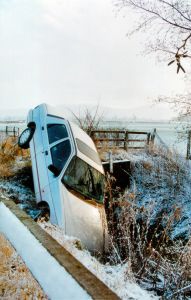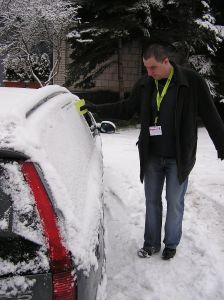 |
Driving in winter conditions requires skill and concentration. Taking a long trip on unknown winter roads requires some preplanning. If you have already taken all the steps before the engine starts, now it’s time to talk about the actual journey.
If your aren’t used to driving on snow or ice be sure to review the Five Tips For Driving on Icy, Slippery or Snow Covered Roads . This time of year can bring surprises when you least expect them and some of the roads we travel may be affected by winter conditions. It’s always a good idea to keep the radio tuned and pay attention to the road reports during your travels.
 |
While Driving:
- Be sure to keep your visibility clear and remove all snow and ice from your vehicle after stopping for lunch or at a rest area. Be sure to remove ice and snow from hood, roof, trunk, turn signal lights, tail and headlights, windows, mirrors and fenders, this keeps things clear for you as the driver, and makes your car clear for other drivers.
- If it starts to snow, use the low beams because they offer better visibility.
- Posted Speed Limits are for ideal weather conditions. Slow down while driving on snow or ice and remember to allow more space for stopping.
- Driving uphill on ice, choose a lane with the most traction, and watch the vehicles ahead. Stay away from areas where other cars spin wheels or slide backward. Unpacked and fresh snow gives most vehicles sufficient uphill traction.
- Keep control on curves and turns, reduce speed going into the turn and slowly accelerate coming out of the turn. Avoid sudden acceleration or deceleration during a turn because that can send the car into a skid.
Safe equipment and understanding how to handle a car in winter weather conditions are only part of traveling safely. Other important things to keep in mind include:
- Stick to your plan, and be sure to contact your main contact person if you change your route, get lost, or take a side trip.
- Try to do as much driving during the daytime rather then the night. In winter conditions, the roads re-freeze when the sun goes down. Night travel is generally less safe anyway and most highways have wonderful hotels all along the way.
- Avoid driving while sleepy. Drowsy drivers cause more accidents then statistics can accurately account for. Night driving or driving too many hours at a time can cause a hypnotic type of sleepiness.
- Take frequent stops and stretch, or change drivers. It might take a little longer to get where you are going, but sometimes the journey is half the fun.
- Stay in Touch with your contact person and try your cell phone frequently, in some areas of the country there is No Cell phone service.
Traveling by car during the winter can be a big risk depending on the roads you choose to travel. Making certain your vehicle is ready, that you know how to drive in slippery conditions and keeping in mind safe long distance driving tips should help most families avoid any horrible situations. But, what if you do get lost, or break down? The next Blog will discuss what to do if you are stranded in the snow or lost in the wilderness.
Photo credits for this blog entry:  (no use restrictions for these photos)
(no use restrictions for these photos)
![]() Related Blogs:
Related Blogs:
- Six Tips Before Starting The Engine On a Winter Car Trip.
- Tips For Driving on Icy, Slippery or Snow Covered Roads
- Auto Insurance Policies 101: Optional Coverage-Collision
Glossary of Insurance Terms:
A | B | C | D | E | F | G | H | I | J-K | L | M | N | O | P | Q-R | S | T | U-V | W-Z
Families.com Blogs are for informational purposes only. Families.com assumes no responsibility for consumer choices. Consumers are reminded that it is their responsibility to research their choices properly and speak to a certified insurance professional prior to making any decision as important as an insurance purchase.

